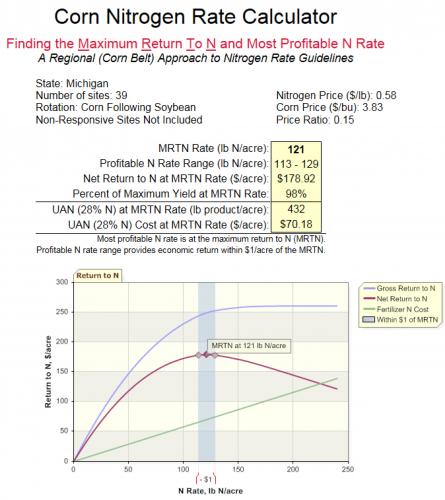Managing nitrogen in corn is a win-win
Selecting the right rate is the first step to good nitrogen management in corn.
Managing nitrogen (N) inputs for the corn crop is a win-win. Good management results in a benefit to the environment and the farm’s bottom-line. As plans are put in place for 2015, they should include an evaluation of the nitrogen program.
The first step to a good nitrogen management program is to apply the right rate of nitrogen. The Maximum Return to N (MRTN) can help determine the most profitable N rate. This web-based decision tool is easy to use and specific to Michigan. All you need to get started is a knowledge of the crop rotation, price per ton of the N fertilizer and your projected selling price for corn.
If the fertilizer has been purchased, the price is known. However, if not, reference the USDA Bi-weekly Fertilizer Report. Likewise, if corn has been priced, the producer has a good idea on average selling price. If not, estimates for corn prices can be found at Michigan State University Extension’s Jim Hilker’s “Market Outlook and Probabilistic Price Forecasts for Grain and Livestock.”
Using fertilizer ($326/t UAN) and corn prices ($3.83) as they are estimated today, and assuming a corn-soybean rotation, the maximum return to N would be 121 pounds of N per acre. The profitable range is 113-129 pounds N per acre (see figure below). This rate should result in 95-98 percent of the maximum yield. Given the price of N and the selling price of corn, this is the N rate that will maximize return. Any additional N applied will cost more than the producer can expect to get back. Ideally, MSU Extension’s recommendation is to apply up to 40 pounds of nitrogen at planting and the balance as a sidedress application.

Each farm will have a little different situation, so producers are encourage to use the MRTN tool to determine the right nitrogen rate for them. If the N rate recommended varies dramatically from what has been used in the past, start slow. Put strips in the field with the MRTN rates and compare it against the rates that have historically been applied. Nitrogen is one of the largest variable expenses for corn production. Using the right rate will improve profitability while decreasing the loss of excess nitrogen to the environment.
For more information on nutrient management, download “Nitrogen Recommendations for Field Crops in Michigan,” MSU Extension Bulletin E2904.



 Print
Print Email
Email